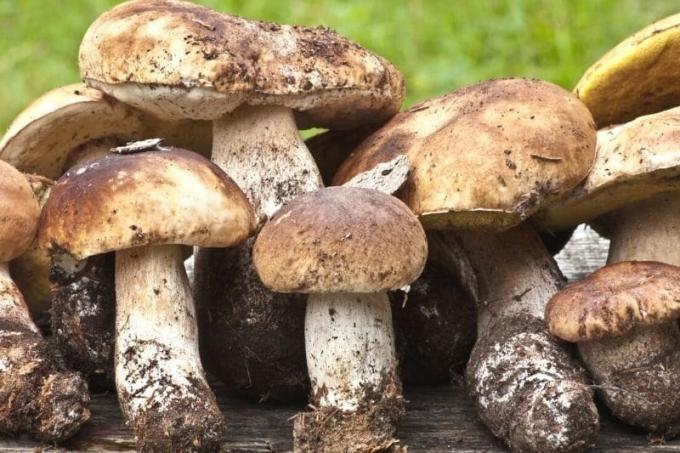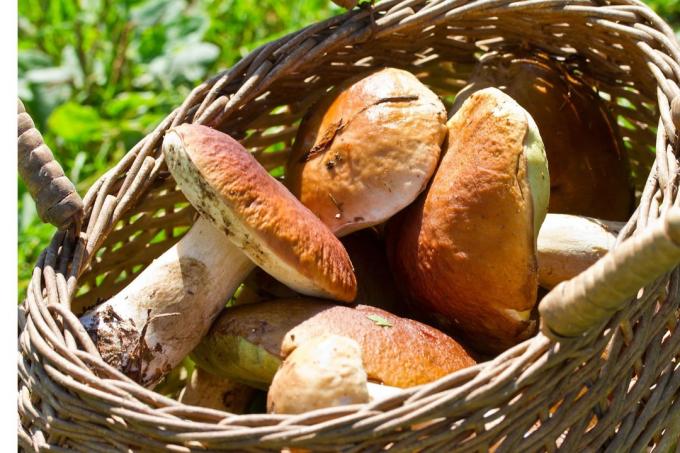
contents
- Know location(s).
- Note accompanying vegetation
- Get up early
- watch out for the weather
- frequently asked Questions
The porcini mushroom is a particularly valued edible mushroom. It is not without reason that mushroom pickers go hunting every year and with a few tips you too can come back with rich loot. We tell you where to find porcini mushrooms.
In a nutshell
- Porcini mushrooms form a symbiosis with various tree species
- Summer porcini grow from May
- Most porcini mushrooms produce fruit in autumn
- preferred locations moist and poor in nutrients
- in humid and moderately warm weather, many mushrooms grow
Know location(s).
It is estimated that up to 13 different species are native to Europe. With some differentiation, however, the experts are not yet in agreement as to whether it is actually a separate species. Each porcini species forms a sensitive mycorrhizal connection with certain trees. Therefore, the location may vary depending on the species. In terms of food quality, there is little difference among the species.
Selection of native species with preferred tree species:
- Common porcini (Boletus edulis): all coniferous and deciduous trees, preferably pine, birch, oak, beech and sweet chestnut
- Pine Boletus (Boletus pinophilus): pines, spruces
- Summer porcini (Boletus reticulatus): beeches, oaks, mixed forests with beeches and firs or beeches and hornbeams
- Black-capped porcini (Boletus aereus): oaks, beeches

The porcini mushroom is the most common because it is very flexible in the selection of its tree partners. The black-hatted porcini is rare, if only in years with a very mild winter.
In addition to the tree species, the location must also meet the following characteristics:
- wet
- light
- no direct sun
Ideal are places where it streams nearby, or the water can collect in depressions for a longer period of time. The tree population should not be too dense, as they also do not like a lot of shade.
Note accompanying vegetation
A nearby host tree is not always recognizable at first glance. Sometimes it no longer exists because it was felled. Nevertheless, you can still find porcini mushrooms in the same place for a few years. Therefore, you should pay attention to the accompanying vegetation. You can avoid areas where stinging nettles (Urtica) or balsam (Impatiens) grow. Porcini mushrooms are only found in areas where the soil is poor and nutrient poor, and both species would grow in very nutrient rich soil Clues.
A sparse but existing vegetation indicates a possible site. Areas with a lot are ideal moss. This is also a sign that there is a lot of moisture, which the ceps appreciate.
Another indication of a location of porcini mushrooms are different mushrooms that have similar requirements. These include, among others:
- Fly agaric (Amanita muscaria)
- Gray Amanita (Amanita spissa)
- Flour weevil (Clitopilus prunulus)
- Pearl Mushroom (Amanita rubescens)

Tip: Other edible mushrooms can also be found near toadstools. These include the real chanterelle (Cantharellus cibarius).
Get up early
If you want to find porcini mushrooms, you should not only start looking early in the day, preferably at sunrise, but also early in the year. If the weather is suitable, you can find the first summer porcini mushrooms as early as May.
The other common species, such as the pine bolete and common bolete, prefer a drop in temperature and start producing fruiting bodies in early autumn.
watch out for the weather
To find a porcini mushroom, you should wait for the weather to be warm but also wet. Continuous rain for one to two days, followed by sunshine again, is ideal. This applies both to the summer porcini mushroom and to the species that only produce fruiting bodies in autumn.
In general, you will not be very successful in your search for mushrooms if the weather is persistently dry. In some years the formation of fruiting bodies can be very sparse or even non-existent if it has not rained for months. If there is another rainy season in autumn, the mycelium is usually so strong drought that it will take at least until next season for the mushrooms to recover to have.

A notice: In very dry years it can happen that collecting popular edible mushrooms completely forbidden is to protect the existing stock.
frequently asked Questions
This is theoretically possible, but in practice all factors really have to be right. In specialist shops you can even buy trees that are already inoculated with porcini mushrooms. Sweet chestnuts are preferred here, since not only do mushrooms grow in the vicinity, but after a few years the sweet chestnut also bears fruit.
How many mushrooms may be collected per day and person can vary greatly. The so-called “hand bouquet rule” applies to fungi, as it does to plants. Small amounts for personal use may usually be collected. However, larger amounts, even if for personal use, are prohibited.
Real mushroom experts would never cut mushrooms. This could leave important features in the soil that can be used to distinguish the porcini mushroom from poisonous species. It is therefore advisable to carefully turn the mushroom whole out of the ground. Also, never collect overaged mushrooms. Toxic decomposition products can form due to aging, which are not destroyed even when cooking.



